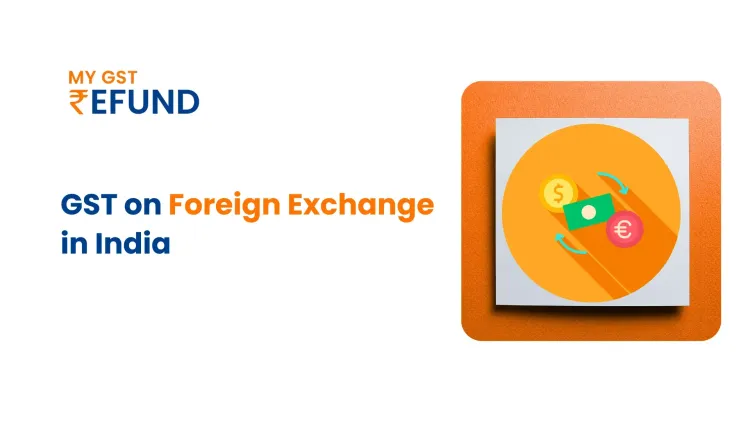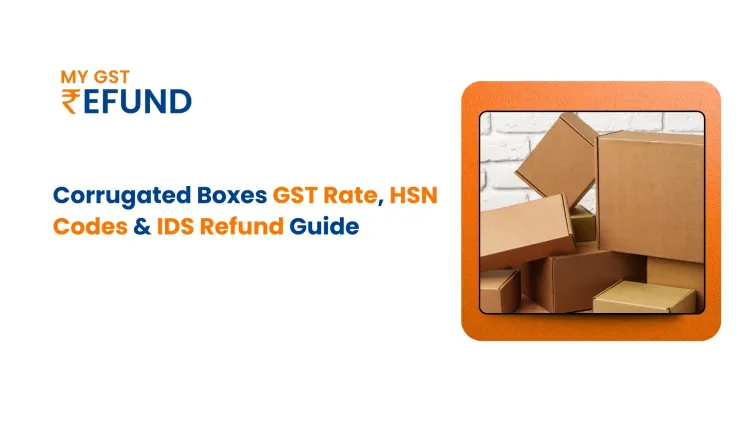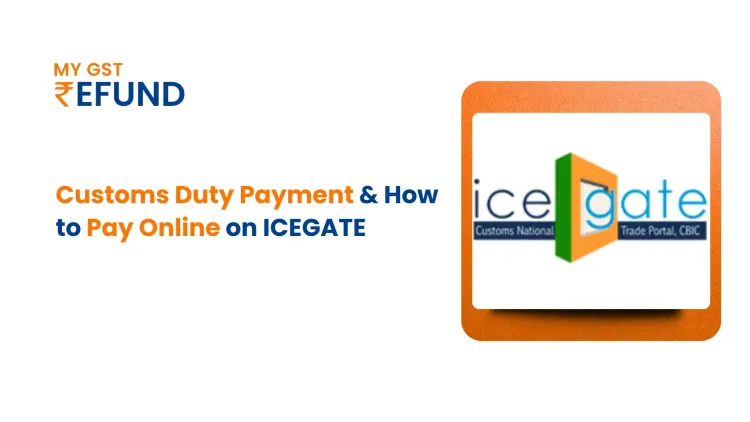Everything About Refund Orders in GST for 2025
Published on: Fri Aug 08 2025
Bio (Reveal/Hide)

Understanding the GST Refund Process
It is the process of returning taxes that have previously been paid when they were not necessary. Businesses may maintain a healthy cash flow and remain in compliance with tax laws by being aware of refund regulations.
When the tax paid exceeds the tax owed, GST refunds are given. This may occur in exports, incorrect payments, or unique situations such as deliveries to Special Economic Zones. Refunds guarantee that firms are not overtaxed, enhance cash flow, and lower operating costs. Businesses might receive their money back fast if the procedure is handled correctly. The businesses, which are particularly MSMEs and exporters, must understand when and how to submit claims for GST refunds.
Different Legal Provisions Controlling GST Refunds
The following covers the refund procedure:
Section 55: For special entities such as embassies or the United Nations.
Section 77: When taxes are paid under the incorrect category (IGST instead of CGST/SGST or vice versa), Section 77 provides a refund if the tax is wrongfully collected and paid to both the Central Government and State Government
There are certain restrictions; refunds are permitted under many conditions. Exports (goods or services) that have duties or tariff drawbacks are not eligible.
Eligibility for the GST Refunds
GST refunds are allowed in certain situations:
- LUT or IGST-exported goods.
- Inverted Duty Structure: means Higher tax on inputs, lower on outputs.
- Excess Payment: Tax mistakes paid.
- Final Provisional Assessment: After the final tax is less than what was paid earlier.
- SEZ Supplies: To Special Economic Zones like Infosys, TCS, and Wipro .
- Deemed Exports: Supplies to Export-Oriented Units (EOUs) like Export-Oriented Units and Export Promotion Capital Goods.
- Incorrectly paid CGST/SGST tax instead of IGST or vice versa.
Types of GST Refunds
Refund on Exports. Exports are zero-rated. Taxpayers may:
- Pay IGST and claim it back.
- Get Input Tax Credit by exporting without IGST using LUT.
Exporters must also submit relevant documents like shipping bills and BRC/FIRC to prove export.
Refund under Inverted Duty Structure
- ITC rises when input tax exceeds output tax.
- Unused Input tax credit can be refunded to businesses. There is no ITC on services or capital products, or goods.This is common in sectors like textiles, fertilizers, and footwear, where input taxes are high and output taxes are low.
Refund of Extra Tax Paid to the Government
Sometimes, the tax is under the wrong head or paid twice to the government. You can ask for a refund claim, which comes under Section 77, which can be claimed before the expiry of two years from the date of payment of tax (CGST) or Section 19 (IGST). Businesses must file correct returns to show proof of excess payment.
Refund on Final Assessment
If the provisional assessment ends with a lower liability, a refund of the extra amount paid is allowed. A copy of the final assessment order is required for refunds.
SEZ Supplies
Supplies to SEZ units/developers are zero-rated. The supplier can:
- Pay tax and claim a refund.
- Not pay LUT tax, obtain ITC.
The SEZ officer’s endorsement is needed on the invoice to prove that the supply was for authorized operations.
Deemed Exports
These include supplies to EOUs or similar. Suppliers or recipients can request refunds. Proof of payment and a declaration from the recipient must be submitted.
Diplomatic Bodies
The UN and embassies can claim a refund under Section 55 if GST is paid on purchases. Proper documentation and government approvals are mandatory.
Documents Required for GST Refund
Refund applications must include:
- Invoice copies.
- Shipping bill or export data.
- The Bank realization certificate (BRC/FIRC) for services.
- GSTR-1 and GSTR-3B match data.
- Statement under Rule 89(2). Means self-declaration, i.e, RFD 01 Form
- Declaration that the burden of tax has not been passed on.
- CA certificate if the refund amount > Rs. 2 lakh.
- SEZ officer endorsed SEZ supplies.
- LUT copy for tax-free zero-rated supplies.
- Declaration from the recipient for considered exports.
All the documents should be carefully prepared and uploaded to avoid deficiency memos.
Procedure for Claiming GST Refund
Step 1: File RFD-01
GST portal refund form. Choose a refund reason and upload documents. Use the correct category and claim period to avoid rejection.
Step 2: RFD-02 Acknowledgment
If the form is complete, the system gives an acknowledgment within 15 days. This means the application is in process.
Step 3: RFD-03 (Deficiency Memo)
If the form has issues, the officer issues RFD-03. The taxpayer must fix errors and reapply. Resets the 60-day refund processing clock.
Step 4: RFD-04 (Provisional Refund)
Exporters can get 90% back in 7 days. This is allowed when there is no risk or past default.
Step 5: RFD-06 (Final Order)
After a full check, the officer issues a refund order in RFD-06. This mentions the accepted, adjusted, or rejected amount.
Step 6: RFD-05 (Payment Advice)
Banks get this form to credit refunds. The refund gets credited to the bank account linked to the GST registration.
Step 7: RFD-07 or RFD-08
Used when a refund is adjusted or rejected. RFD-09 allows the taxpayer to reply.
Time Limits for Filing Refund Claims
Section 54(1) requires repayment to be sought within 2 years:
- Export: Invoice or shipping bill date.
- Tax overpaid: Date of payment.
- Final assessment: Date of final order.
- Deemed export: Date of invoice.
- SEZ supply: Date of invoice or endorsement by SEZ officer.
For erroneous tax payment (Section 77), 2 years after the right payment.
If a refund is not claimed in time, it is barred by limitation. Timely filing is critical to avoid rejection.
RFD-06: GST Refund Order
RFD-06 is the final approval form. It shows:
- ARN and date of application.
- Total claimed and sanctioned amount.
- If any interest is due.
- Adjustments done.
- Rejected portion with reason.
It must be issued within 60 days of filing the refund application. If delayed, interest @ 6% per annum is payable by the department.
Gst refund circular 125
It is filing a refund of unutilized ITC on account of export
Download- https://cbic-gst.gov.in/pdf/circular-cgst-125.pdf
https://tax.assam.gov.in/GST/FORMATS/CIRCULAR%20NO%20125%202022%20GST.pdf
GST refund for exporters
As per Section 54 of the CGST Act, exporters must file refund claims within two years from the relevant date of export.
GST Refund Status
You can go and track your refund application after logging into the GST Portal through the ARN Number of the filing year of the refund application. It will take hardly 45-60 days from the date of receipt of the application.
How MyGST Refund is helping exporters to claim a refund
MyGST Refund is India's first automated GST refund filing platform. It simplifies the entire GST export refund procedure for exporters. The platform offers assistance like "Know Your GST Refund," a calculator, refund pre-checks, and automatic filing modules for refunds and returns; it facilitates filing, tracking, and status updates.
How mygstrefund Works for exporters
Mygstrefund works on a zero-risk “no success, no fee” model.
The service follows a contingency model; they charge only if the refund is successfully secured.
Types of Export Refunds
Refund Support for both,
- whether you're exporting under payment of IGST or
- using a Letter of Undertaking (LUT).
MyGST Refund assists in claiming:
- Refund of paid IGST, or
- Refund of unutilized Input Tax Credit (ITC) when exporting without paying IGST.
How the Export Refund Process Works (via GST Law)
Exports are treated as zero-rated supplies under GST. Exporters can claim gst refund on IGST paid, or we can have LUT-based zero-rated exports with ITC refunds.
Refund applications are submitted through Form RFD-01 on the GST portal, often accompanied by supporting documents such as shipping bills, GST returns (e.g., GSTR-1, GSTR-3 B), and Bank Realization Certificates (BRCs).
Timelines of GST refund
GST authorities typically process refunds within 60 days of application; delayed processing incurs a 6% annual interest. Additionally, exporters may receive 90% of the refund provisionally within 7 days if the application is complete
How MyGST Refund Helps Exporters
MyGST Refund aims to simplify and speed up the GST export refund process through:
- A user-friendly automated platform with built-in refund tools and calculators
- A “no success, no fee” pricing model to reduce upfront risk
- Support across both IGST-paid and LUT-based export scenarios
- Enhanced documentation support and faster processing for improved liquidity
Frequently Asked Questions
1. Who can receive a refund?
Refunds are available to those registered taxpayers who have paid excess tax or made qualified supplies, such as exports or SEZ transactions.
2. What is the timeframe to apply for a refund of GST?
According to Section 54 of the CGST Act, a refund must be requested within two years of the relevant date.
3. Can I receive my export-related IGST refund?
Yes, you are eligible for a refund of the tax paid if exports are made after IGST has been paid.
4. Does an inverted duty structure permit a refund? (till this)
Yes, you can get a refund in conditions; if the input tax rate is higher than the output tax rate, the cumulative input tax credit may be refunded.
4. How long does it take to receive a refund for GST?
Refunds should be received within a maximum of 60 days. A 90% temporary refund is given for exports within seven days. The tax credit may be refunded.
5. How long does it take to receive a refund for GST?
Refunds should normally be given out within 60 days. A 90% temporary refund is given for exports within seven days.
6. If my request for a refund is denied, what will happen?
You will receive Form RFD-08 with the reasons for rejection. Form RFD-09 can be used to reply.
7. Can my GST liability be reduced by a refund?
Yes, the department can use Form RFD-07 Part A to deduct your refund from any unpaid balances.
8. Can I claim GST on goods that I export?
Exports are zero-rated under the GST. Exporters can receive a refund for the taxes they paid on goods and services. You are not required to pay tax on their sales.
9. How can I find out the status of my GST refund?
Go to Services > Monitor the Status of Your Application > Choose the Refund option > Enter the Filing Year or ARN. After entering the GST Portal, click SEARCH to follow the progress of your refund application. After logging into the GST Portal using your ARN or the refund application's filing year, you can follow the progress of your refund application.
10. What is the time frame for a GST refund?
Yes, you can get a refund, which must be approved within 60 days of the application being received.
Related Posts





